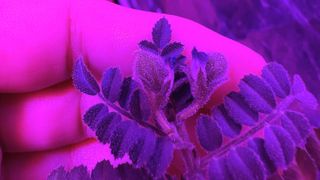
First chickpea seeds in amended moondust.
(Image credit: Courtesy of Jessica Atkin)
Researchers have for the first time grown chickpea seeds in soil similar to that found on the moon, paving the way to reduce dependency on packaged foods during future crewed missions.
“The moon doesn’t have soil like Earth does,” Jessica Atkin, a graduate student at Texas A&M University who is one of the two co-authors of the new study yet to be peer-reviewed, said in a statement.
Unlike the soil on Earth, lunar soil lacks organic matter rich in nutrients and microorganisms whose presence is crucial for plant growth. “This adds to other challenges, such as reduced gravity, radiation and toxic elements.”
Successfully growing plants on the moon has tangible benefits. The foremost is that it’d provide a sustainable, nutritious resource for future spacefarers, reducing the need to re-supply packaged foods from Earth — an expensive endeavor which doesn’t yet meet the demands of long-term space missions. Furthermore, the moon’s thin atmosphere is not suitable for us oxygen-dependent Earthlings, so plants on the moon could also offer a source of breathable air for future astronauts.
Because lunar soil isn’t friendly toward Earth-like plants, however, even after adding compost mixtures, Atkin and her colleagues think changing the soil’s chemical and physical properties could facilitate the presence of beneficial microorganisms. This spurred the new study.
Yet, there wasn’t sufficient moon soil on Earth — brought home by the Apollo missions — for the experiments, so Atkin and her colleagues used “amended moondust,” a material engineered from Earth’s geological materials to replicate lunar soil, such as its minerals and the size of its characteristic particles. The study team hypothesized that the microscopic interactions between chickpeas, arbuscular mycorrhizal fungi (AMF) and vermicompost (VC) would help plant growth by sequestering toxins from the amended moondust and changing its structure to improve water retention and tolerance toward stress. To test that hypothesis, the team used AMF in varying concentrations of amended moondust and vermicompost mixture.
The study team potted chickpea seeds, chosen for the plant’s compact size and resilience toward stress. “They are a great protein source and use less water and nitrogen than other food crops,” Atkin said in the same statement. “We used a desi chickpea variety to deal with the space limitations inside a habitat.”
For the next four months, the containers were stored in a temperature-controlled grow tent, where researchers moistened the soil with purified water.
On day 13, all seeds had germinated but the plants that eventually sprouted showed chlorophyll deficiency as well as other signs of stress, including dwarfism, loss of leaf area and either reduced shoot branching or lack of it. These could be due to the soil’s poor water retention capacity, according to the new study.
At day 13, there were 100% germination rates. Experiments are labeled as in Figure 2. Potting mix (control) shows large leaves and greater branching, whereas plants in lunar regolith simulant mixtures show signs of xenomorphism, with reduced leaf area, reduced amount of leaf growth, and smaller shoot height. (Image credit: Courtesy of Jessica Atkin)
The chickpeas also required 120 days to mature in the experiment, whereas on Earth they usually take just 100 days. The produced chickpeas “will need to be tested for heavy metal concentrations, and we’re going to do that,” Atkin told New Scientist.
Despite the limitations, researchers say these early results may offer a way to grow plants in-situ on the moon. After all, the study has led to the first time chickpeas have been grown in moondust, albeit a simulated version.
“The novelty about using vermiculture is that it can all be done in space, whether in a space station or on the moon, reducing the need for resupply missions,” Atkin added.
This research is described in a preprint paper posted on biorxiv.
Join our Space Forums to keep talking space on the latest missions, night sky and more! And if you have a news tip, correction or comment, let us know at: community@space.com.
Breaking space news, the latest updates on rocket launches, skywatching events and more!
Sharmila is a Seattle-based science journalist. She found her love for astronomy in Carl Sagan’s The Pale Blue Dot and has been hooked ever since. She holds an MA in Journalism from Northeastern University and has been a contributing writer for Astronomy Magazine since 2017. Follow her on Twitter at @skuthunur.
>>> Read full article>>>
Copyright for syndicated content belongs to the linked Source : Space.com – https://www.space.com/the-universe/moon/lunar-astronauts-could-potentially-make-hummus-with-moon-grown-chickpeas
